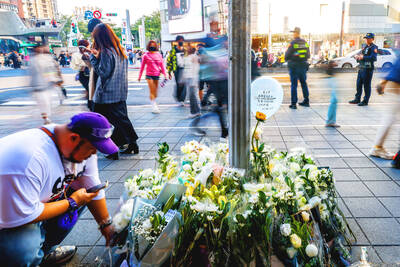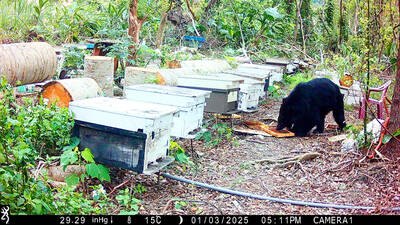Taiwanese researchers have identified a gene that they say might help doctors treat diabetes.
A study by a research team at Academia Sinica’s Agricultural Biotechnology Research Center showed that the expression of protein disulfide isomerase family A member 4 (PDIA4) is linked to diabetes.
The research was published in this month’s issue of EMBO Molecular Medicine, an open-source, peer-reviewed scientific journal based in Europe.

Photo courtesy of Yang Wen-chin
When people — or mice, which also carry PDIA4 — are overnourished, expression of the protein-coding gene increases in the beta cells of the pancreas, the study said.
This triggers a process that leads to metabolic stress and eventual death of the pancreatic cells that secrete insulin, resulting in diabetes, it said.
Removing the gene from diabetic mice alleviates their condition in a number of ways, including lessening the destruction of pancreatic cells, lowering blood sugar levels and increasing insulin secretion, it said.
Eliminating the gene can sometimes fully reverse diabetes in mice, which might occur without intervention or in combination with a reduced diet, the study said.
In addition, the scientists created a PDIA4 inhibitor they call PS1 that suppresses the progression of diabetes in mice, it said.
These findings show that the PDIA4 gene could be the key in the search for a cure for diabetes, it said.
Lead researcher Yang Wen-chin (楊文欽), a research fellow at the center, on Thursday said that the gene has the potential to become the first-ever therapeutic treatment for diabetes, should it pass clinical trials.
Ministry of Health and Welfare data show that 9.8 percent of Taiwanese have diabetes, while the National Health Insurance pays NT$30 billion (US$1.08 billion) annually in medical expenses related to the condition.

SHIPS, TRAINS AND AUTOMOBILES: The ministry has announced changes to varied transportation industries taking effect soon, with a number of effects for passengers Beginning next month, the post office is canceling signature upon delivery and written inquiry services for international registered small packets in accordance with the new policy of the Universal Postal Union, the Ministry of Transportation and Communications said yesterday. The new policy does not apply to packets that are to be delivered to China, the ministry said. Senders of international registered small packets would receive a NT$10 rebate on postage if the packets are sent from Jan. 1 to March 31, it added. The ministry said that three other policies are also scheduled to take effect next month. International cruise ship operators

HORROR STORIES: One victim recounted not realizing they had been stabbed and seeing people bleeding, while another recalled breaking down in tears after fleeing A man on Friday died after he tried to fight the knife-wielding suspect who went on a stabbing spree near two of Taipei’s busiest metro stations, Taipei Mayor Chiang Wan-an (蔣萬安) said. The 57-year-old man, identified by his family name, Yu (余), encountered the suspect at Exit M7 of Taipei Main Station and immediately tried to stop him, but was fatally wounded and later died, Chiang said, calling the incident “heartbreaking.” Yu’s family would receive at least NT$5 million (US$158,584) in compensation through the Taipei Rapid Transit Corp’s (TRTC) insurance coverage, he said after convening an emergency security response meeting yesterday morning. National

PLANNED: The suspect visited the crime scene before the killings, seeking information on how to access the roof, and had extensively researched a 2014 stabbing incident The suspect in a stabbing attack that killed three people and injured 11 in Taipei on Friday had planned the assault and set fires at other locations earlier in the day, law enforcement officials said yesterday. National Police Agency (NPA) Director-General Chang Jung-hsin (張榮興) said the suspect, a 27-year-old man named Chang Wen (張文), began the attacks at 3:40pm, first setting off smoke bombs on a road, damaging cars and motorbikes. Earlier, Chang Wen set fire to a rental room where he was staying on Gongyuan Road in Zhongzheng District (中正), Chang Jung-hsin said. The suspect later threw smoke grenades near two exits

The Forestry and Nature Conservation Agency yesterday launched a gift box to market honey “certified by a Formosan black bear” in appreciation of a beekeeper’s amicable interaction with a honey-thieving bear. Beekeeper Chih Ming-chen (池明鎮) in January inspected his bee farm in Hualien County’s Jhuosi Township (卓溪) and found that more than 20 beehives had been destroyed and many hives were eaten, with bear droppings and paw prints near the destroyed hives, the agency said. Chih returned to the farm to move the remaining beehives away that evening when he encountered a Formosan black bear only 20m away, the agency said. The bear